JavaScript is disabled for your browser. Some features of this site may not work without it.
Buscar en RiuNet
Listar
Mi cuenta
Estadísticas
Ayuda RiuNet
Admin. UPV
Silica-Based Stimuli-Responsive Systems for Antitumor Drug Delivery and Controlled Release
Mostrar el registro sencillo del ítem
Ficheros en el ítem
| dc.contributor.author | Corma Canós, Avelino
|
es_ES |
| dc.contributor.author | BOTELLA ASUNCION, PABLO
|
es_ES |
| dc.contributor.author | Rivero-Buceta, Eva María
|
es_ES |
| dc.date.accessioned | 2023-11-07T19:02:34Z | |
| dc.date.available | 2023-11-07T19:02:34Z | |
| dc.date.issued | 2022-01 | es_ES |
| dc.identifier.uri | http://hdl.handle.net/10251/199455 | |
| dc.description.abstract | [EN] The administration of cytotoxic drugs in classical chemotherapy is frequently limited by water solubility, low plasmatic stability, and a myriad of secondary effects associated with their diffusion to healthy tissue. In this sense, novel pharmaceutical forms able to deliver selectively these drugs to the malign cells, and imposing a space-time precise control of their discharge, are needed. In the last two decades, silica nanoparticles have been proposed as safe vehicles for antitumor molecules due to their stability in physiological medium, high surface area and easy functionalization, and good biocompatibility. In this review, we focus on silica-based nanomedicines provided with specific mechanisms for intracellular drug release. According to silica nature (amorphous, mesostructured, and hybrids) nanocarriers responding to a variety of stimuli endogenously (e.g., pH, redox potential, and enzyme activity) or exogenously (e.g., magnetic field, light, temperature, and ultrasound) are proposed. Furthermore, the incorporation of targeting molecules (e.g., monoclonal antibodies) that interact with specific cell membrane receptors allows a selective delivery to cancer cells to be carried out. Eventually, we present some remarks on the most important formulations in the pipeline for clinical approval, and we discuss the most difficult tasks to tackle in the near future, in order to extend the use of these nanomedicines to real patients. | es_ES |
| dc.description.sponsorship | FundingFinancial support from Spanish Ministry of Science and Innovation (Projects PID2019-111436RB-C21 and SEV-2016-0683), and the Generalitat Valenciana (Project PROMETEO/2017/060) is gratefully acknowledged. | es_ES |
| dc.language | Inglés | es_ES |
| dc.publisher | MDPI AG | es_ES |
| dc.relation.ispartof | Pharmaceutics | es_ES |
| dc.rights | Reconocimiento (by) | es_ES |
| dc.subject | Silica nanoparticles | es_ES |
| dc.subject | Drug delivery | es_ES |
| dc.subject | Stimuli-responsive | es_ES |
| dc.subject | Controlled release | es_ES |
| dc.subject | Cancer therapy | es_ES |
| dc.subject | Camptothecin | es_ES |
| dc.subject | Docetaxel | es_ES |
| dc.subject | Doxorubicin | es_ES |
| dc.title | Silica-Based Stimuli-Responsive Systems for Antitumor Drug Delivery and Controlled Release | es_ES |
| dc.type | Artículo | es_ES |
| dc.identifier.doi | 10.3390/pharmaceutics14010110 | es_ES |
| dc.relation.projectID | info:eu-repo/grantAgreement/AEI/Plan Estatal de Investigación Científica y Técnica y de Innovación 2017-2020/PID2019-111436RB-C21/ES/IMAGEN FOTOACUSTICA CON NANOPARTICUTLAS CON PROPIEDADES OPTOELECTRONICAS Y MAGNETICAS/ | es_ES |
| dc.relation.projectID | info:eu-repo/grantAgreement/MINISTERIO DE ECONOMÍA, INDUSTRIA Y COMPETITIVIDAD//SEV-2016-0683//Programa Estatal de Fomento de la Investigación Científica y Técnica de Excelencia/ | es_ES |
| dc.relation.projectID | info:eu-repo/grantAgreement/GVA//PROMETEO%2F2017%2F060//El pasado lejano: aproximación a la conducta y la ocupación del territorio en el Paleolítico valenciano/ | es_ES |
| dc.rights.accessRights | Abierto | es_ES |
| dc.contributor.affiliation | Universitat Politècnica de València. Instituto Universitario Mixto de Tecnología Química - Institut Universitari Mixt de Tecnologia Química | es_ES |
| dc.description.bibliographicCitation | Corma Canós, A.; Botella Asuncion, P.; Rivero-Buceta, EM. (2022). Silica-Based Stimuli-Responsive Systems for Antitumor Drug Delivery and Controlled Release. Pharmaceutics. 14(1):1-25. https://doi.org/10.3390/pharmaceutics14010110 | es_ES |
| dc.description.accrualMethod | S | es_ES |
| dc.relation.publisherversion | https://doi.org/10.3390/pharmaceutics14010110 | es_ES |
| dc.description.upvformatpinicio | 1 | es_ES |
| dc.description.upvformatpfin | 25 | es_ES |
| dc.type.version | info:eu-repo/semantics/publishedVersion | es_ES |
| dc.description.volume | 14 | es_ES |
| dc.description.issue | 1 | es_ES |
| dc.identifier.eissn | 1999-4923 | es_ES |
| dc.identifier.pmid | 35057006 | es_ES |
| dc.identifier.pmcid | PMC8779356 | es_ES |
| dc.relation.pasarela | S\457041 | es_ES |
| dc.contributor.funder | Generalitat Valenciana | es_ES |
| dc.contributor.funder | Agencia Estatal de Investigación | es_ES |
| dc.contributor.funder | MINISTERIO DE ECONOMÍA, INDUSTRIA Y COMPETITIVIDAD | es_ES |








